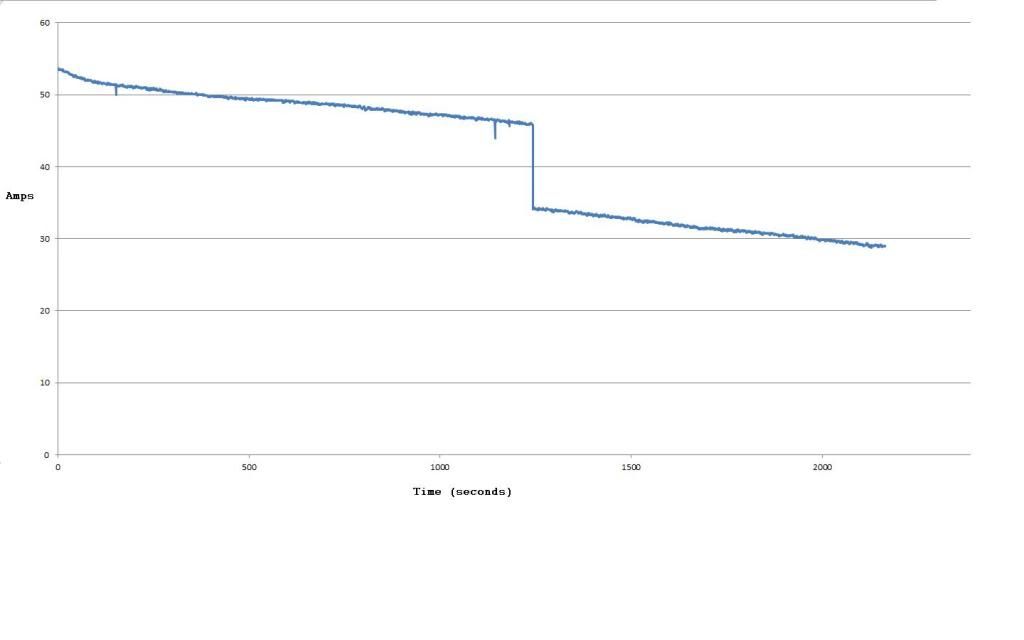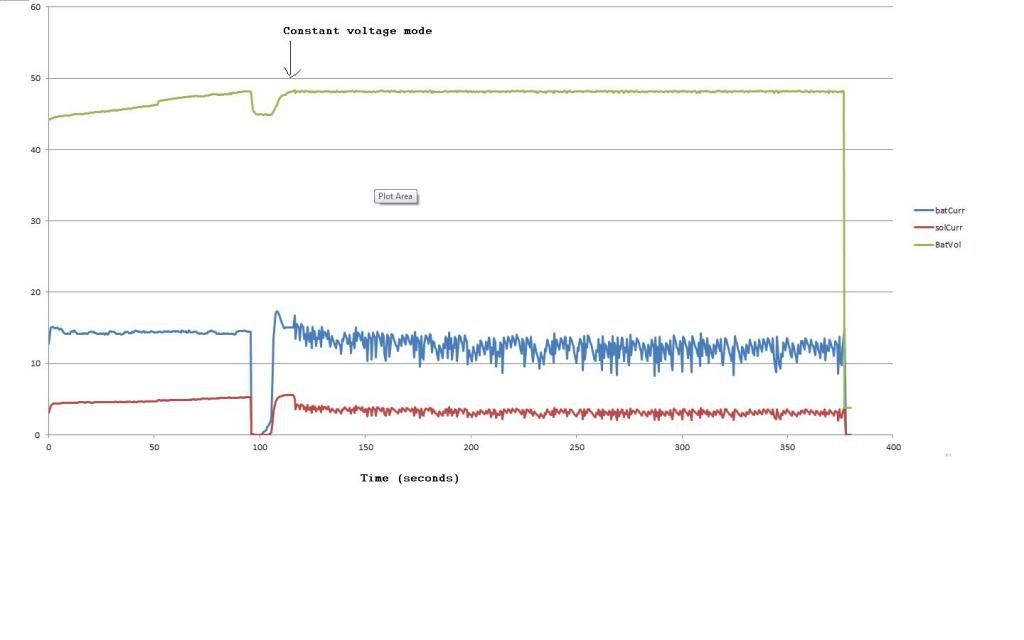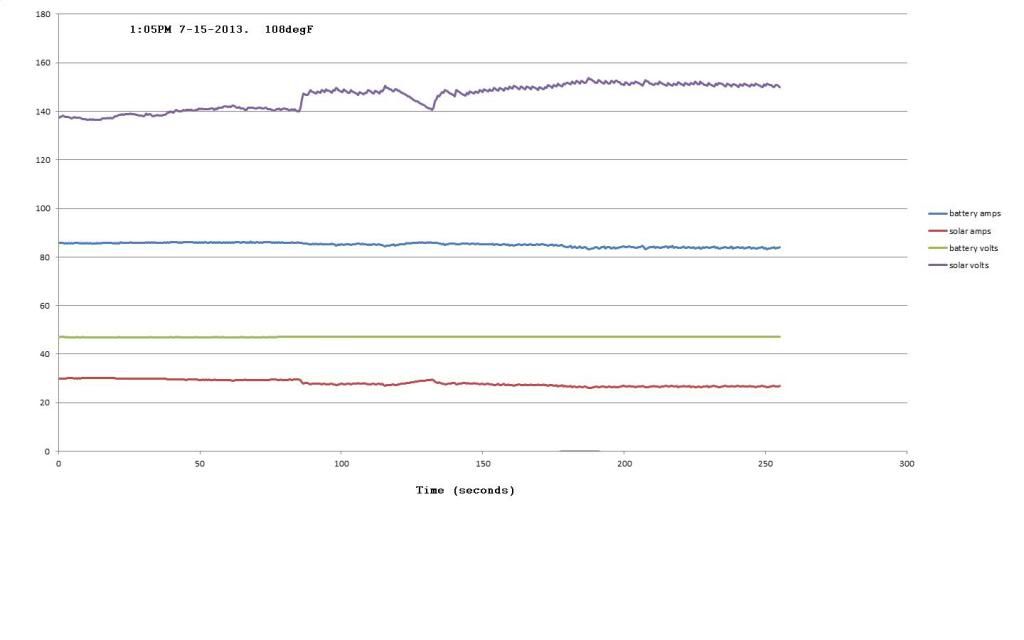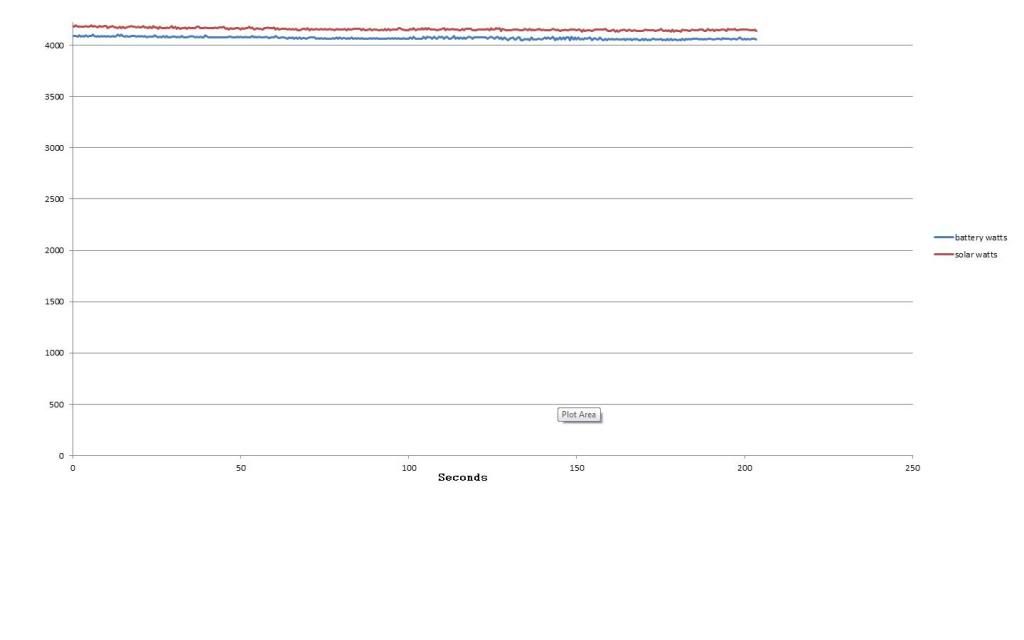diy MPPT data
MPaulHolmes
Solar Expert Posts: 35 ✭✭
I figured I'd quit hijacking that poor guy's thread, and post data here of my diy MPPT tracker. Here's the latest picture:
I waited until like 4:45PM or so before turning on all the panels to keep the amps down. I'm still testing it out, and don't want to blow up my battery bank. There are 20 280W panels in 4 strings of 5 panels per string. This one started at around 53 amps output to 48v, and the sun was gradually setting, so the power (and amps) kept falling. Then my stupid computer fell asleep after me not touching anything for some time, and it woke up with much lower amps because the sun had gone down some. The short spikes of lower current were when a couple clouds drifted past the sun, but they weren't enough to really block it much.

I waited until like 4:45PM or so before turning on all the panels to keep the amps down. I'm still testing it out, and don't want to blow up my battery bank. There are 20 280W panels in 4 strings of 5 panels per string. This one started at around 53 amps output to 48v, and the sun was gradually setting, so the power (and amps) kept falling. Then my stupid computer fell asleep after me not touching anything for some time, and it woke up with much lower amps because the sun had gone down some. The short spikes of lower current were when a couple clouds drifted past the sun, but they weren't enough to really block it much.

Comments
-
Re: diy MPPT data
I was actually learning a lot from your post. As I'm going to buy or DIY a MPPT charger in near future InsALLAH.
Just change "put computer to sleep" to never. -
Re: diy MPPT data
In the service I once ran the calculations for a navigational 'Schuler Loop' (F-4s used analog computers). That was enuff. Now, I happily buy the tools to do that work
-
Re: diy MPPT data
What's this?? More data? haha. I finally got the transition from MPPT to constant voltage mode working pretty well I think. According to my fluke multimeter, there's a fluctuation of the "constant voltage" of about +/- 0.01v. Good enough for government work. I dumped one of the 6v batteries, since my ... long story. I'd really rather not talk about it. HAHA.
What I have it do is, if the voltage drops below the "constant voltage point", a timer starts. If it stays below the constant voltage point for a certain specified time, it switches back to MPPT mode. -
Re: diy MPPT dataMPaulHolmes wrote: »I dumped one of the 6v batteries, since my ... long story. I'd really rather not talk about it. HAHA.
So, this graph is done with only 7 batteries, thatr is 42V battery bank?
That's the advantage of custom controller. If you remove one battery, you can re-program it for any voltage of the bank. Must have a custom inverter too
-
Re: diy MPPT data
Yep, 42v battery bank. Sort of odd ballish, but you are right. Just change the voltage stopping point to whatever you want, and hit compile! haha. Or just make it a programmable setting... I should do that. Ya, it's also a custom inverter too. -
Re: diy MPPT data
so what I will need for a 30A MPPT ?
A pic controller, PWM kit etc ? -
Re: diy MPPT data
I don't think you could do a kit that's cheaper than what's available for 30A. The savings happen when you really crank the current and voltage up to hundreds of amps and hundreds of volts. Actually, everything gets easier. You use a sledgehammer for every problem that a clever engineer could work around. -
Re: diy MPPT dataMPaulHolmes wrote: »I don't think you could do a kit that's cheaper than what's available for 30A. The savings happen when you really crank the current and voltage up to hundreds of amps and hundreds of volts. Actually, everything gets easier. You use a sledgehammer for every problem that a clever engineer could work around.
some of options ava. are
http://www.solar-electric.com/sbchco2512vm.html $182.
http://www.solar-electric.com/blue-sky-energy-solar-charge-controller-sb2512i-hv.html $187
http://www.solar-electric.com/blue-sky-energy-solar-charge-controller-sb2512ix-hv.html $222
So IMHO, a MPPT can DIYed for alot less than this. -
Re: diy MPPT data
You could get a functional thing maybe for less than that, but with my approach, you already passed $182 on the input capacitor. Or one of the 2 contactors. Or the IGBT. -
Re: diy MPPT dataMPaulHolmes wrote: »You could get a functional thing maybe for less than that, but with my approach, you already passed $182 on the input capacitor. Or one of the 2 contactors. Or the IGBT.
Contractors are easily ava. second hand for like 2.5K to 6K ~ 25 to 50$. Yes I can go beyond 30A limit. -
Re: diy MPPT data
I did the first high power test, all panels, with no clouds. I made sure two 12200BTU air conditioners were running off of the inverter before turning the charger on so the charging amps wouldn't be ridiculous.
This was the transition to constant voltage mode at 1:05 pm or so. The current oscillation is much more calm now while holding at the constant voltage.
At this point, the current out of the charger had fallen to around 85 or 86 amps. It did over 85 amps continuous with an IGBT hotspot temperature of about 12 degrees C over ambient. Ambient was around 115 F inside the shop. Thermal cutback starts at 75 degC, so I still had quite a bit of room.
Here's what the power in and power out looked like at around 12:35. At that time the current out of the charger had made it to a little over 88 amps. Not very interesting when there are no clouds!:
-
Re: diy MPPT data
Where do you buy these monstrous components - IGBTs, Capacitors, Inductors? -
Re: diy MPPT data
600v 600amp igbt module from Digikey:
http://www.digikey.com/product-detail/en/CM600DY-12NF/835-1023-ND/1989675 (but I got a new one on Ebay for like $40 I think. It was from someone I trusted, and still had all the paperwork from the company proving they were new)
600v 500uF capacitor. These are amazing. Developed for the military. Probably 5 times better than the competitor:
http://www.futureelectronics.com/en/technologies/passives/capacitors/film-capacitors/Pages/5211230-700D50796-349.aspx?IM=0
300uH 200amp continuous inductor:
http://www.digikey.com/product-detail/en/CH-200/CH-200-ND/1984836
The inductor runs pretty cool at 90 amps (the peak so far). Well, the shop is 120 deg, and the inductor is 10-15 degrees warmer than that, so maybe not "cool", but well below danger territory. -
Re: diy MPPT dataMPaulHolmes wrote: »600v 500uF capacitor. These are amazing. Developed for the military.
Never seen anything like this one.
500uF looks a little too small. At 50A and your 10kHz switching, the ripple will be around 10V - may go too far away from the MPPT point at the extremes.
Or do you do have high voltage strings, so you get like 300V and 20A?MPaulHolmes wrote: »300uH 200amp continuous inductor.
$400 for an inductor looks lika a lot to me. Have you thought about winding your own? -
Re: diy MPPT data$400 for an inductor looks lika a lot to me. Have you thought about winding your own?
Looks like a lot to me too: http://www.solar-electric.com/xaxwmp60amps.html
DIY is obviously not the cheap option for charge controllers. :roll: -
Re: diy MPPT data
They have higher uF versions, but I just went with that, since it's fairly small. I am doing around 200v at 25A. It was a lot for the inductor. I tried winding my own toroid inductor and it worked for lower current. I haven't tried a high current version though. I just had that one laying around from a few years ago because I was using it (along with some heavy nichrome wire for added resistance) to test a motor controller when I didn't have a motor.
I'm not using the input current and input voltage at all for computing the maximum point point. Just maximizing the output current (since it's connected to a 48v battery pack. Well, actually maximizing the average of the last 512 samples of the output current. The output capacitance is a 4700uF electrolytic rated for 450v. I didn't post the link to that one since it was just a random capacitor I had laying around, and I have no idea what part it was, and it's stinking hot outside! I'm not checking. hahaha.
I could run this one up to around 350v output though at 200 amps. It's been running at 50degC ambient shop temperature with an output of 90 amps peak (around noon) 12 hours per day. Of course, it's not working quite as hard in the morning and evening. haha. Darn that sun. I'm going to test it out at 350v in the next few weeks, so we'll see how it goes. Of course, it won't be at 200 amps, since my panels won't quite do 200 amps at 350v. Maybe I can sneak on to the Frito Lay solar field that's just south of where I live. They have a huge array. I'd have to also sneak 350v worth of lead acid batteries with me. -
Re: diy MPPT dataCariboocoot wrote: »Looks like a lot to me too: http://www.solar-electric.com/xaxwmp60amps.html
DIY is obviously not the cheap option for charge controllers. :roll:
Not at that level of voltage and amperage.
On the other hand Linear Technology and Texas Instrument now both offer small scale MPPT controllers on a chip that can be had for a few bucks each! . For small scale charging someone could probably incorporate a few of these into a fairly low cost DIY box.
ADD- For a larger inexpensive DIY mppt controller - big enough to actually charge 12V battery there's Tim Nolan's Arduino CC -
Re: diy MPPT dataMPaulHolmes wrote: »I'm not using the input current and input voltage at all for computing the maximum point point. Just maximizing the output current (since it's connected to a 48v battery pack. Well, actually maximizing the average of the last 512 samples of the output current.
Whether you use the input measurements or not, they do affect the performance.
MPPT point is a point. There is some voltage and current associated with it.
When you turn on your transistor, the capacitor start discharging, so its voltage drops. The current from panels stay the same (may increase a bit). As a result, the total power taken from panels decreases. As seen by panels, you're now below the MPPT point.
Now, when you turn it off, panels start to charge the capacitor. Voltage goes up. It passes the MPPT point and goes beyond it. The current decreases, and total power decreases too. As seen by panels, you're now above MPPT point.
Therefore, because of the ripple, you do not sit exactly at the point, but oscillate around it with your switching frequency. The bigger the capacitor, the lower the amplitude of the oscillation. Therefore, with bigger capacitor you do not move very far from MPPT and, as a result, produce more energy. 500 uF capacitor is probably good for your high voltage setup - the voltage should vary only 1-2%, but bigger capacitor would still be better.
If there was 10% ripple (as you should expect from your controller if you run input at about 70V) or more, the oscillation would be wide around the MPPT point and panels would spend only a fraction of the time in the vicinity of the MPPT point. This would lead to smaller harvest. At the same time, the efficiency measured as a ratio of outgoing to incoming power would be roughly the same regardless of the size of the ripple.
With 150V drop you should have problems with heat from switching losses in IGBT. How do you deal with that? -
Re: diy MPPT data
Oh I see what you are saying. That makes a lot of sense.
I'm using a pretty small gate resistor (3 Ohms) and the VLA500-01 igbt driver turns it on and off hard, so it's not in the linear region very much. The laminated bus with the capacitor with 100uOhm makes for a small turnoff spike even though it's happening so fast. It does get warm, but nothing to write home about. -
Re: diy MPPT data
You switch at 10KHz. This is an audible frequency. Could be making terrible noises. Can you hear it? Is it loud? -
Re: diy MPPT data
I hear it barely, but my inverter is right next to it, making a buzzing noise. Then I usually have a fan blowing if I'm working out there as it's 120 degrees. haha. Then I usually have my geared head milling machine running at the same time. So, overall the 10kHz isn't noticeable to me as EVERYTHING is stinking noisy out there. -
Re: diy MPPT dataMPaulHolmes wrote: »I hear it barely, but my inverter is right next to it, making a buzzing noise. Then I usually have a fan blowing if I'm working out there as it's 120 degrees. haha. Then I usually have my geared head milling machine running at the same time. So, overall the 10kHz isn't noticeable to me as EVERYTHING is stinking noisy out there.
Milling machine is a really good way to silence noisy electronics!
Categories
- All Categories
- 233 Forum & Website
- 141 Solar Forum News and Announcements
- 1.4K Solar News, Reviews, & Product Announcements
- 199 Solar Information links & sources, event announcements
- 900 Solar Product Reviews & Opinions
- 256 Solar Skeptics, Hype, & Scams Corner
- 22.5K Solar Electric Power, Wind Power & Balance of System
- 3.5K General Solar Power Topics
- 6.7K Solar Beginners Corner
- 1K PV Installers Forum - NEC, Wiring, Installation
- 2.1K Advanced Solar Electric Technical Forum
- 5.6K Off Grid Solar & Battery Systems
- 429 Caravan, Recreational Vehicle, and Marine Power Systems
- 1.1K Grid Tie and Grid Interactive Systems
- 656 Solar Water Pumping
- 816 Wind Power Generation
- 624 Energy Use & Conservation
- 623 Discussion Forums/Café
- 315 In the Weeds--Member's Choice
- 75 Construction
- 125 New Battery Technologies
- 108 Old Battery Tech Discussions
- 3.8K Solar News - Automatic Feed
- 3.8K Solar Energy News RSS Feed
